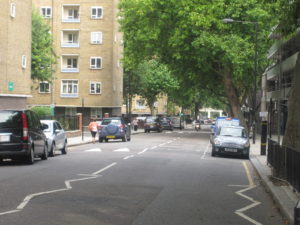Living on the edge
16 Thursday Aug 2018
Tags
Central London, council housing, HS2, Jason Crowthorne, Liam Glass, location, Nash terraces, railway, Regents Park
Living on the edge.
It was one of these special places on the edge of things.
Where you place a novel or screenplay is one of the most important decisions a writer makes. 
As I started planning the novel that was to become The Breaking of Liam Glass, the Regent’s Park Estate immediately appealed to me. It was one of those locations I love. A place that exists on the borders.
A mixed-up part of London, full of mixed-up people, it’s both middle-class and working class, white and migrant, and yet at the same time none of these exactly.
Glamour and seriousness
You’ll find it just north of Central London, a short distance from the West End. Squeezed between the rich glamour of Regents Park, the neon buzz of Central London and the squat seriousness of Euston.
There are relatively cheap flats — though nothing is that cheap in London any more — and expensive ones.
High-rise blocks tower over low — pensioners scratch along next to smart-casual media consultants — bankers in Reiss suits live beside teenage gangsters in shades.
If you park your car next to one of the little squares, you don’t know if you’re going to come back and find a glossy leaflet for Hatha Yoga under the wipers… or the wheels gone and the car up on bricks…
Nash terraces and railway workers
No more than 200 years ago, everything here was countryside. Indeed, there’s a small park nearby where you can see a contemporary  engraving of the view from Russell Square – nothing but fields, sheep and cows all the way to the hills of Hampstead.
engraving of the view from Russell Square – nothing but fields, sheep and cows all the way to the hills of Hampstead.
In the early 1800s, however, London began to expand north. Almost from the start, the area was a mix-up.
On the one hand, elegant Nash terraces, on the other, cheap housing for the navvies needed to build the new railway stations at Euston, St Pancras and Kings Cross.
Many of these workmen and their families came from Ireland. And when the Luftwaffe destroyed many of the Nash terraces and railway houses, it was their descendants who lived in many of the new council blocks that rose up in the 1950s, soon to be joined by Bengalis, largely from the town of Silhet.
(Back in those days, governments had the strange belief that it was good to provide homes people could afford. We’ve grown out of such silly ideas today).
Tensions and trickery
Things changed yet again when Margaret Thatcher’s 1980 Housing Act gave council tenants the right to buy their homes. Many did and were rewarded with the start of what was to become the massive escalation of London prices that we still see today.
The result was to create a fascinating if edgy patchwork of people from all backgrounds.
From those whose families have been here from the very start, right through to the newly rich who can afford to buy flats within a few minutes walk from the centre of town.
Like a border town between different countries and yet here the borders are internal, hidden, invisible.
It felt like the perfect location for my drama of knifing, racial tensions and newspaper trickery to play out.
It would be here that Liam Glass lived with his single-parent mother.
Here that he made the fatal decision to borrow her card to get cash for a pizza.
And here where journalist Jason Crowthorne – also on the edge – would find the scoop that might make him – or ruin him.
PS:
Since writing the book there’s been a new development.
What the railways create, the railways can destroy.
The Regent’s Park Estates are being partly knocked down for the overpriced mess that is called HS2 – a so-called high-speed line to the north of England that will cost billions and is being attacked as a Government vanity project and an environmental disaster.
But maybe that’s another irony, for another novel down the line.
Further reading:
The Regent’s Park Estate, St Pancras: ‘catering for the main bulk and backbone of our people’


2 Comments
August 8, 2020 at 7:47 pm
highly recommend if you’ve read Room 15 to read this!
August 9, 2020 at 7:02 pm
Kathryn, thank you.